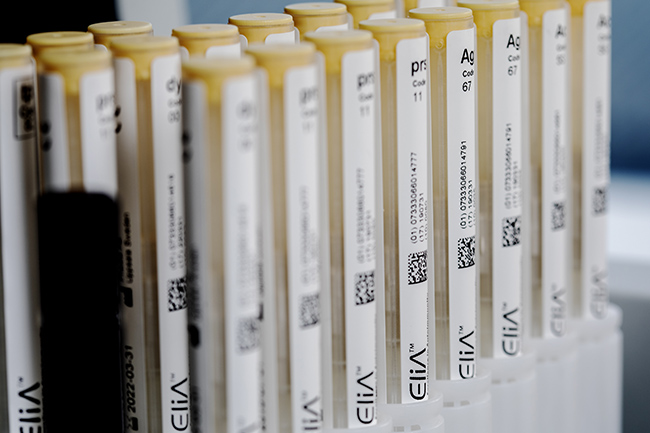Published: May 2025
Medically reviewed by:
Gary Falcetano, PA-C, AE-C
Selecting, interpreting, and applying insights with ImmunoCAP Specific IgE blood tests
When patients present with symptoms like sneezing, itchy eyes, and a runny nose, it’s difficult to know the cause. Is it the new puppy, high pollen levels, dust mites, or all of the above? It’s time to test and take control.
Creating a culture of testing helps give patients answers, and Thermo Fisher Scientific is here to support you every step of the way.

With ImmunoCAP™ Specific IgE blood testing, healthcare professionals and labs alike can confidently help patients improve their quality of life through informed allergy management.
You can:
- Help patients understand allergic vs. non-allergic triggers
- Provide specific management advice based upon their sensitization profile to help them reduce exposure and associated symptoms
- Optimize their medication selection
- Provide improved patient satisfaction by providing insights and preventative medicine measures.
Who to test
Look for patients with symptoms and a history of:
Rhinorrhea
Coughing
Chest tightness
Itchy/watery eyes
Nasal congestion
Sneezing
Wheezing
Shortness of breath
Ear pressure
Why test
Specific IgE blood testing with respiratory allergens can help you uncover the full picture.
1. Helps to rule in/rule out allergy
If you test your patient for specific IgE-mediated allergic triggers and get a negative result, it suggests that additional investigation of the underlying causes of their symptoms is required.
2. Identify triggers
Identifying your patient’s allergic triggers can help them stay below their symptom threshold—the point where they start experiencing allergy symptoms.1
3. Reduce exposure
Reducing exposure to triggers can take several paths – from avoiding certain allergens completely to doing simple mitigation measures at home like dust mite covers for bedding.
4. Improve symptoms
All of this allows you to create more targeted and successful treatment plans.2 Testing is important for medication selection (especially when over-the-counter meds aren't working) and efficacy
What to order
You can order respiratory allergen profiles with reflex to allergen components, which contain the most common indoor and seasonal (location-specific) allergens.
Profiles contain:
Tree pollens
Weed pollens
Grass pollens
Dust mites
Molds
Pet dander
Mouse urine
Cockroach
By understanding the symptoms and the allergens potentially triggering them, you can pave the way for more targeted patient management and better outcomes.2
How to order
You can order ImmunoCAP Specific IgE blood testing from national or local laboratories. The Lab Ordering Guide (LOG) helps you search for allergy profile test codes with confidence.
With the Lab Ordering Guide, you can:
- Filter by zip code and allergy profile type.
- Receive customized search results from labs you already use.
- Discover recommended allergen profile test codes.
- Copy test codes for ease of ordering.
How to interpret
You've received results for your patient's specific IgE blood test. Now what?
- Combine test results with the patient's history, symptoms and physical exam findings to inform your understanding and decision making.3
- Results indicate the patient's level of sensitization to specific allergens, measured in kilounits of allergen-specific IgE per liter of blood (kUA/L).
Once you have test results, you can use our interpretation guides to help you confidently understand the results, as well as potential clinical implications to aid in your diagnosis and patient management plan.
When it comes to respiratory symptoms, let’s test
Complementing patient history, symptoms and physical exams with specific IgE testing gives clinicians valuable insights into suspected allergies, which may lead to better patient outcomes. For patients struggling with respiratory symptoms this allergy season, ImmunoCAP Specific IgE testing helps find the answers.
Want this information in an easy to digest PDF? Get our Respiratory Allergy Toolkit.



